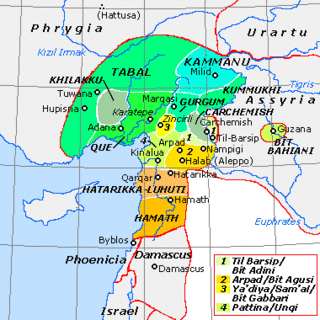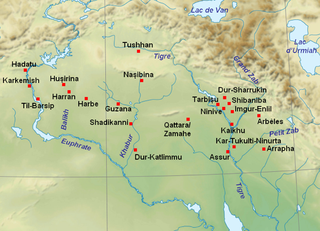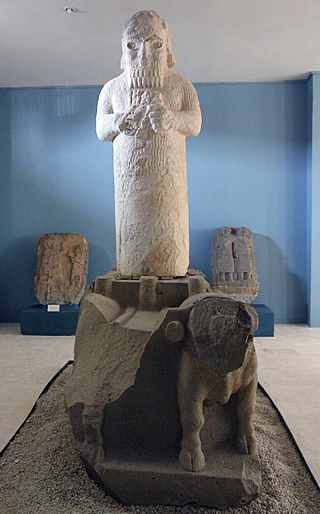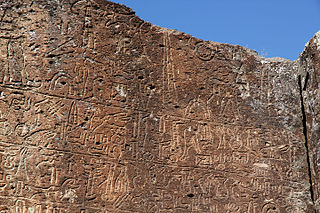Related Research Articles
Tunna, also Dunna or Atuna, was an ancient Anatolian city. In classical antiquity Tunna was known as Tynna. Today it is known as Porsuk Hüyük or Zeyve Höyük.

Carchemish, also spelled Karkemish was an important ancient capital in the northern part of the region of Syria. At times during its history the city was independent, but it was also part of the Mitanni, Hittite and Neo-Assyrian Empires. Today it is on the frontier between Turkey and Syria.

Tabal was a Luwian speaking Neo-Hittite kingdom of South Central Anatolia during the Iron Age. According to archaeologist Kurt Bittel, references to Tabal first appeared after the collapse of the Hittite Empire. Tabal was likely an exonym applied by the Assyrians to Cappadocia. While its native name is uncertain, it is possible that it was called Sura, as mentioned in the records of Yariri, ruler of Carchemish.

Tyana, earlier known as Tuwana and Tuwanuwa was an ancient city in the Anatolian region of Cappadocia, in modern Kemerhisar, Niğde Province, Central Anatolia, Turkey. It was the capital of a Luwian-speaking Neo-Hittite kingdom in the 1st millennium BC.

The states called Syro-Hittite, Neo-Hittite, or Luwian-Aramean, were Luwian and Aramean regional polities of the Iron Age, situated in southeastern parts of modern Turkey and northwestern parts of modern Syria, known in ancient times as lands of Hatti and Aram. They arose following the collapse of the Hittite New Kingdom in the 12th century BCE, and lasted until they were subdued by the Assyrian Empire in the 8th century BCE. They are grouped together by scholars, on the basis of several cultural criteria, that are recognized as similar and mutually shared between both societies, northern (Luwian) and southern (Aramean). Cultural exchange between those societies is seen as a specific regional phenomenon, particularly in light of significant linguistic distinctions between the two main regional languages, with Luwian belonging to the Anatolian group of Indo-European languages, and Aramaic belonging to the Northwest Semitic group of Semitic languages. Several questions related to regional grouping of Luwian and Aramaean states are viewed differently among scholars, including some views that are critical towards such grouping in general.

Til Barsip or Til Barsib is an ancient site situated in Aleppo Governorate, Syria by the Euphrates river about 20 kilometers south of ancient Carchemish.

Bit Adini, a city or region of Syria, called sometimes Bit Adini in Assyrian sources, was an Aramaean state that existed as an independent kingdom during the 10th and 9th centuries BC, with its capital at Til Barsib. The city is considered one of the two chief states of the Aramean-held territories in the Euphrates along with Carchemish.

Karatepe is a late Hittite fortress and open-air museum in Osmaniye Province in southern Turkey lying at a distance of about 23 km from the district center of Kadirli. It is sited in the Taurus Mountains, on the right bank of the Ceyhan River. The site is contained within Karatepe-Aslantaş National Park.

The Luwians were a group of Anatolian peoples who lived in central, western, and southern Anatolia, in present-day Turkey, during the Bronze Age and the Iron Age. They spoke the Luwian language, an Indo-European language of the Anatolian sub-family, which was written in cuneiform imported from Mesopotamia, and a unique native hieroglyphic script, which was sometimes used by the linguistically-related Hittites as well.
Sangara or Sangar was a king of Carchemish. He belonged to the House of Suhi of Carchemish, and ruled from 870 to 848 BC.

The Çineköy inscription is an ancient bilingual inscription, written in Hieroglyphic Luwian and Phoenician languages. The inscription is dated to the second half of the 8th century BC. It was uncovered in 1997 near the village of Çine, that is located some 30 km south of Adana, capital city of the Adana Province in southern Turkey.
Kuzi-Teshub was a Neo-Hittite King of Carchemish, reigning in the early to mid-12th century BC, likely in 1180-1150 BC. He was the son of Talmi-Teshub, who was both the last viceroy of the Hittite Empire at Carchemish under Suppiluliuma II and a direct descendant of Suppiluliuma I. Kuzi-Teshub reigned in Carchemish as well as in the later Neo-Hittite city of Melid.

Palistin, was an early Syro-Hittite kingdom located in what is now northwestern Syria and the southeastern Turkish province of Hatay. Its existence was confirmed by the discovery of several inscriptions mentioning Taita, king of Palistin.

Irhuleni was King of Hamath. He led a coalition against the Assyrian expansion under Shalmaneser III, alongside Hadadezer of Damascus. This coalition succeeded in 853 BC in the Battle of Qarqar a victory over the Assyrians, halting their advance to the west for two years. Later Irhuleni maintained good relations with Assyria. His son was, in Luwian, Uratami.
The House of Astiruwa was the last known dynasty of rulers of Carchemish. The members of this dynasty are best known to us through Hieroglyphic Luwian sources. One member of the House of Astiruwa may also be referred to in Assyrian sources.

Gurgum was a Neo-Hittite state in Anatolia, known from the 10th to the 7th century BC. Its name is given as Gurgum in Assyrian sources, while its native name seems to have been Kurkuma for the reason that the capital of Gurgum—Marqas in Assyrian sources —was named "the Kurkumaean city" in local Hieroglyphic Luwian inscriptions.
Hartapu was an Anatolian king in the 8th century BCE. He is known from Hieroglyphic Luwian inscriptions from Kizildağ, Mount Karadağ, Burunkaya near Aksaray, and most recently Türkmen-Karahöyük, site of a monumental stele in which he claimed victory over the kingdom of Phrygia, ruled around that time by King Midas.

Hittite art was produced by the Hittite civilization in ancient Anatolia, in modern-day Turkey, and also stretching into Syria during the second millennium BCE from the nineteenth century up until the twelfth century BCE. This period falls under the Anatolian Bronze Age. It is characterized by a long tradition of canonized images and motifs rearranged, while still being recognizable, by artists to convey meaning to a largely illiterate population.
“Owing to the limited vocabulary of figural types [and motifs], invention for the Hittite artist usually was a matter of combining and manipulating the units to form more complex compositions"

Wasusarma was a neo-Hittite king from Tabal, who ruled from around 740/38–730 BCE. He carried the titles of great king and hero, like his father Tuwati II before him.
References
- ↑ Trevor Bryce: The World of the Neo-Hittite Kingdoms: A Political and Military History. Oxford, New York 2012, p. 89, 93.
- ↑ Trevor Bryce: The World of the Neo-Hittite Kingdoms: A Political and Military History. Oxford, New York 2012, p. 94.
- ↑ Trevor Bryce: The World of the Neo-Hittite Kingdoms: A Political and Military History. Oxford, New York 2012, p. 88 ff.
- ↑ Alessandra Gilibert: Syro-Hittite Monumental Art and the Archaeology of Performance. Berlin 2011, p. 135.
- ↑ Trevor Bryce: The World of the Neo-Hittite Kingdoms: A Political and Military History. Oxford, New York 2012, p. 88 ff.
- ↑ Annick Payne: Iron Age Hieroglyphic Luwian Inscriptions. Atlanta 2012, p. 6.
- ↑ Alessandra Gilibert: Syro-Hittite Monumental Art and the Archaeology of Performance. Berlin 2011, p. 135.
- ↑ Trevor Bryce: The World of the Neo-Hittite Kingdoms: A Political and Military History. Oxford, New York 2012, p. 90 f.
- ↑ Alessandra Gilibert: Syro-Hittite Monumental Art and the Archaeology of Performance. Berlin 2011, p. 135.
- ↑ Trevor Bryce: The World of the Neo-Hittite Kingdoms: A Political and Military History. Oxford, New York 2012, p. 91 f.
- ↑ Trevor Bryce: The World of the Neo-Hittite Kingdoms: A Political and Military History. Oxford, New York 2012, p. 92.
- ↑ Gwendolyn Leick: Who's Who in the Ancient Near East. London 1999, 2002, p. 91.
- ↑ Annick Payne: Iron Age Hieroglyphic Luwian Inscriptions. Atlanta 2012, p. 68, 75 f.
- ↑ Annick Payne: Iron Age Hieroglyphic Luwian Inscriptions. Atlanta 2012, p. 68.
- ↑ Annick Payne: Iron Age Hieroglyphic Luwian Inscriptions. Atlanta 2012, p. 72.
- ↑ Trevor Bryce: The World of the Neo-Hittite Kingdoms: A Political and Military History. Oxford, New York 2012, p. 92.
- ↑ Annick Payne: Iron Age Hieroglyphic Luwian Inscriptions. Atlanta 2012, p. 68.
- ↑ Trevor Bryce: The World of the Neo-Hittite Kingdoms: A Political and Military History. Oxford, New York 2012, p. 90.
- ↑ Trevor Bryce: The World of the Neo-Hittite Kingdoms: A Political and Military History. Oxford, New York 2012, p. 93.
- ↑ Trevor Bryce: The World of the Neo-Hittite Kingdoms: A Political and Military History. Oxford, New York 2012, p. 213.
- ↑ Marchetti, Nicolò; Peker, Hasan (2018-07-16). "The Stele of Kubaba by Kamani and the Kings of Karkemish in the 9th Century BC". Zeitschrift für Assyriologie und vorderasiatische Archäologie. Walter de Gruyter GmbH. 108 (1): 81–99. doi:10.1515/za-2018-0006. ISSN 0084-5299. S2CID 165166999.
- ↑ Trevor Bryce: The World of the Neo-Hittite Kingdoms: A Political and Military History. Oxford, New York 2012, p. 302.